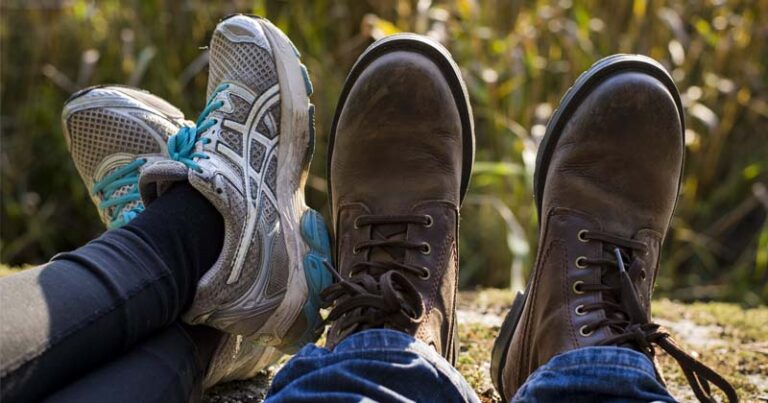How to Hike With Bad Knees
If you have bad knees, it is still possible to go hiking. Here are a few tips to keep in mind:
1) Choose trails with minimal elevation and avoid steep inclines as much as possible.
2) Wear shoes or boots that provide good arch support and cushioning for your feet. Also, consider investing in knee braces or wraps for extra support during the hike.
3) Take breaks if needed and remember to stretch before, during, and after the hike so that your muscles stay loose.
4) Bring along trekking poles to help reduce stress on your joints while providing additional stability when navigating uneven terrain.
5) Pack light but be sure to include food, water, a first aid kit, flashlight/headlamp, map/GPS device, etc., just in case of an emergency situation arises while out on the trail.
- Talk to Your Doctor: Before you set out on a hike, it is important that you talk with your doctor about the potential risks associated with the activity and what precautions you should take before hiking
- This includes ensuring that your knees are up to the task and discussing any alternatives if they are not
- Wear Proper Footwear: Wearing supportive shoes or boots can help reduce stress on your knees while hiking by providing better cushioning for your feet and giving more traction in slippery areas
- Make sure these shoes fit properly so as not to cause further knee strain
- It may also be beneficial to wear braces designed specifically for knee support while walking or running outdoors, especially over rougher terrain like rocks or roots
- Take Frequent Breaks: When hiking with bad knees, it is important to take frequent breaks throughout the day so that you can give them time to rest and recuperate between stretches of walking (or climbing)
- Take advantage of scenic spots along the trail where you can stop, catch some air, stretch out, and enjoy a snack while taking in nature’s beauty! Doing this will help keep your body from getting too tired which could lead to extra pain in those tender knees of yours!
- Modify Your Route: If possible, try modifying your route slightly by avoiding sharp inclines or declines as much as possible since these steep grades put added strain on already-tired joints like those found within our lower legs and knees! Try going at a slower pace than normal; this will allow for more breaks but also let gravity do most of the work when navigating downhill sections – minimizing the impact on joints even further!

Credit: thetrek.co
Can I Go Hiking With Bad Knees?
Hiking can be a great way to experience the beauty of nature and get some much-needed exercise. But if you have bad knees, it might seem like an impossibility. Fortunately, hiking with bad knees doesn’t have to be completely out of the question.
With a few simple modifications, you can still enjoy all the benefits of hitting the trails without putting too much strain on your joints. First off, make sure that you are wearing supportive shoes that provide adequate cushioning for your feet and ankles — this will help reduce pressure on your knees while walking or climbing over uneven terrain. Additionally, try using trekking poles to take some of the weight off your legs; not only do they help support balance but also act as shock absorbers when descending steep hillsides.
Finally, consider cutting down on distance by breaking up longer hikes into smaller sections — this allows for more frequent breaks and reduces fatigue in between rest periods which ultimately helps protect your knee joints from further damage during long treks in rough terrain.
How Do I Stop My Knees from Hurting When Hiking?
If your knees are hurting when hiking, there are several things you can do to ease the pain and help prevent further damage. First, make sure that you have the right gear for your hike: choose a comfortable pair of shoes with sufficient cushioning and support, as well as supportive socks that absorb sweat. Additionally, it is important to warm up before beginning any strenuous activity such as hiking; this can be done by taking a short walk or doing some simple dynamic stretches like leg swings.
When on the trail, you should also take regular breaks in order to give your knees time to rest and stretch out any tight muscles. It is also important to ensure proper posture while walking—keep your back straight and avoid leaning too far forward or sideways—and maintain an even pace throughout the duration of the hike so that you don’t overexert yourself. Lastly, if knee pain persists after these preventive measures have been taken, consider talking to a doctor about what else may be causing it and possible solutions.
How Do You Hike With Arthritis in the Knee?
If you have arthritis in your knee, it can be difficult to go hiking. However, there are several ways that you can make the experience more enjoyable and less painful. First, remember to always listen to your body and stop if something hurts or feels uncomfortable.
Wear supportive shoes with good arch support; this will help reduce pain while walking up hills or uneven terrain. Additionally, consider using trekking poles which take some of the strain off of your knees by providing extra stability when climbing over rocks or navigating slippery paths. Make sure to rest often during long hikes and allow yourself plenty of time for breaks so that your joints don’t become overly inflamed from too much movement.
It is also important to stay hydrated throughout your hike as dehydration can worsen joint inflammation. Finally, prior stretching before a hike helps keep muscles flexible and limbers up joints which allows for a better range of motion on the trail without causing too much discomfort or pain in the knee area due to arthritis flareups.
How Can I Make My Knees Stronger for Hiking?
If you’re an avid hiker or are just starting to get into the hobby, strengthening your knees is a key component of enjoying the activity and reducing stress on your joints. Fortunately, there are several exercises that can help you build up strength in your knees and make them better able to withstand long hikes. Squats are one of the most effective ways to strengthen both the quadriceps muscles at the front of your thigh as well as those around your knee joint.
Lunges also target similar muscles but add an element of balance which further strengthens these muscles. Step-ups involve stepping onto a platform or step using only one foot at a time, alternating feet with each repetition; this exercise works many different muscle groups including those around the knee joint for increased stability when hiking over uneven terrain. Strengthening exercises should be done two to three times per week with rest days in between for optimal results; if possible, incorporate some light cardio activities like jogging or swimming into your routine as well since they will help improve overall fitness while decreasing the risk of injury during physical activities such as hiking.
STOP Knee PAIN When HIKING Downhill
Knee Support for Hiking Downhill
Hiking downhill can be hard on your knees, so it is important to have the right support. Knee supports for hiking downhill provide cushioning and stability, helping to reduce strain on the joints while also reducing fatigue in the muscles. They are typically made of a breathable fabric that allows sweat to evaporate, keeping you cool and comfortable during long hikes.
Look for knee supports with adjustable straps for a secure fit and an ergonomic design that contours to your body’s shape. Wearing knee supports can help prevent injuries while allowing you to move more freely and enjoy your hike even longer!
Hiking Knee Support
Knee support is essential when hiking, especially for those who are new to the activity. Wearing a knee brace or compression sleeve can help provide stability and reduce the risk of injury while engaging in strenuous activities such as climbing over rocks and roots on trails. Knee support also helps with shock absorption, which can prevent pain from developing in your joints during long hikes.
How to Tape Knees for Downhill Hiking
Wearing knee support during downhill hiking is important for protecting your knees from the strain of going down steep terrain. To properly tape your knees, start by wrapping an elastic bandage around the knee in a figure-eight pattern, covering both sides of the joint and overlapping each layer slightly. Make sure to keep it snug but not too tight.
For extra stability, apply two strips of athletic or kinesiology tape over the bandage; one strip should go horizontally across the kneecap and another strip should run vertically along either side of the knee joint. Finish with a second layer of elastic bandage if desired for additional support.
Knee Pain When Hiking Downhill
Hiking downhill can be a great way to enjoy the outdoors, but it can also put extra strain on your knees. As you descend, the weight of your body is transferred from one leg to the other which causes an increase in pressure on the knee joint. This can cause pain and discomfort for some people, especially those with pre-existing knee conditions.
To help reduce stress on your knees while hiking downhill, wear supportive shoes with good arch support and use trekking poles for balance and stability. Additionally, if possible take breaks during long descents and alternate between short bursts of walking quickly followed by periods of slower walking or even standing still to give your joints a break.
Conclusion
This blog post has provided some useful tips for those with bad knees who want to go hiking. If you need to hike with bad knees, proper stretching and rest are extremely important before, during, and after the hike. Taking regular breaks can help reduce the impact of an uneven terrain on your joints.
Additionally, it is helpful to use trekking poles or a walking stick while you are out on the trail in order to provide better balance and stability. By following these simple steps, even those with bad knees can still enjoy a safe and enjoyable hiking experience!





